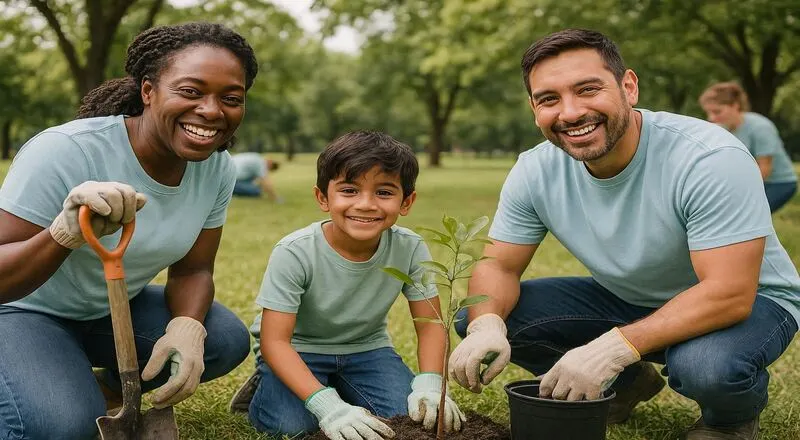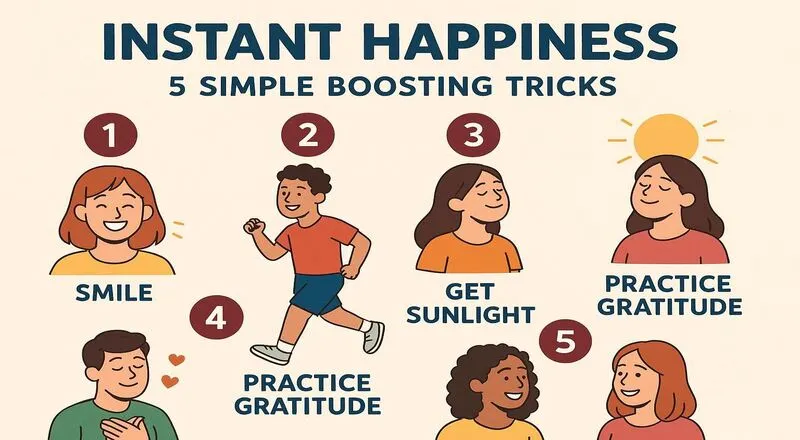liife is complex, throwing curveballs from daily stress to major changes. Feeling overwhelmed is normal. True happiness isn’t a destination but found in moments.
Life’s complexity, from daily stress to major changes, often causes overwhelm. We often see happiness as a distant goal. However, science and wisdom confirm that instant, powerful joy boosts are possible through simple, deliberate shifts in mindset and action, regardless of circumstances. These small actions provide an immediate uplift.
Think of it like this: your emotional state isn’t a fixed entity. It’s fluid, capable of being nudged and steered. Just as a small pebble can create ripples across a pond, a small, intentional act can send positive waves through your well-being. And the beauty of these tricks? They’re accessible to everyone, from the youngest among us discovering the world, to seasoned individuals navigating life’s later chapters. They require no special equipment, no prior experience, and best of all, they’re entirely within your control.
Today, we’re exploring five simple yet incredibly effective tricks designed to instantly boost your happiness meter. These aren’t just feel-good platitudes; they’re rooted in psychological research and proven to foster positive emotions, reduce stress, and enhance your overall sense of well-being. So, if you’re ready to inject a little more sparkle into your day, let’s explore these powerful shortcuts to a brighter mood.
Embrace the Power of Gratitude

In our fast-paced world, it’s remarkably easy to get caught up in what we lack, what went wrong, or what we’re still striving for. Our brains, with their evolutionary bias towards negativity (a survival mechanism designed to spot threats), often default to scanning for problems. While this served our ancestors well, in modern life, it can lead to a pervasive sense of dissatisfaction and stress. This is where gratitude steps in as a revolutionary force.
Gratitude goes beyond simply saying “thank you.” It’s about intentionally recognizing and valuing the positive things, whether big or small, that are present in your life at this moment. It means shifting your focus from what’s missing to what’s present, from what’s problematic to what’s working, from what’s ordinary to what’s extraordinary (even if only slightly so). It’s recognizing the inherent value and benefit of people, experiences, objects, and even abstract concepts like health or sunshine.
Why Gratitude Works Wonders Instantly:Happiness
The moment you consciously choose to feel grateful, a powerful shift occurs within your brain. Research by psychologists like Dr. Robert Emmons and Dr. Michael McCullough has consistently shown that practicing gratitude can literally rewire your brain over time, making you more prone to positive emotions. But even in a single moment, it can:
Shift Perspective: It immediately moves your focus away from negative thoughts or stressors, forcing your mind to acknowledge positivity. This interruptive pattern can break a downward spiral of thinking.
Boost Neurotransmitters: Feeling gratitude triggers the release of dopamine and serotonin, the neurotransmitters responsible for making you feel good. These chemicals naturally elevate your mood, increase feelings of contentment, and improve your sense of well-being.
Reduce Stress: By focusing on the positive, you signal to your nervous system that you are safe and content, which can lower cortisol levels (the stress hormone) and promote a sense of calm.
Enhance Empathy: Being grateful for others’ actions or presence can strengthen your social bonds and foster feelings of connection.
Improve Self-Esteem: Recognizing the good things you have or have contributed to can boost your self-worth and appreciation for your own life.
Simple Ways to Practice Gratitude for an Instant Boost:
You don’t need a lengthy ritual; a few seconds of intentional gratitude can make a difference.
The “Three Good Things” Moment: Take a minute to mentally list three things you are genuinely grateful for right now. It could be the warmth of your coffee, the sound of birds outside, a kind word from a friend, or even just the fact that you woke up today. The key is to genuinely feel the gratitude.
Express It Directly: Send a quick text or make a short call to someone you appreciate, simply to thank them for something specific. Even a brief, heartfelt “Thanks for always making me laugh” or “I appreciate you listening” can make both of you feel good.
Gratitude Walk/Commute: As you walk or travel, consciously notice and appreciate five things around you – the vibrant colors of a flower, the strength of a tree, the clear blue sky, the comfort of your shoes, the efficiency of public transport.
The Gratitude Habit: Before eating, mentally or physically thank the food’s origin and preparation. Alternatively, write a five-minute thank-you note to someone.
Mindful Appreciation: When something pleasant occurs, pause and fully savor it. Taste the delicious, really see the beautiful. Let the appreciation sink in.
This shift from lack to abundance is a potent antidote to negativity, highlighting life’s existing pockets of good. As Cicero noted, “Gratitude is not only the greatest of virtues, but the parent of all the others.” Cultivating gratitude as a micro-habit transforms your internal landscape, opening the door to other positive emotions.
Get Your Body Moving, Even A Little

When you’re feeling low, the last thing you might want to do is move. The couch, a blanket, and a good distraction can seem far more appealing. However, research overwhelmingly demonstrates a profound and immediate connection between physical activity and emotional well-being. You don’t need to commit to an hour-long sweat session or run a marathon to reap the benefits; even small, consistent bursts of movement can dramatically elevate your mood and energy.
Our bodies and minds are intricately linked. Modern life often encourages long periods of sedentary behavior, which can contribute to feelings of sluggishness, stress, and even depression. Our ancestors were constantly active, and our physiology is still designed for movement. When we deny our bodies this fundamental need, it can have ripple effects on our mental state.
Why Movement is an Instant Mood Booster:
The benefits of physical activity for mental health are vast and well-documented. For an instant boost, here’s what happens:
Endorphin Release: Often called “nature’s painkillers” or “the body’s feel-good chemicals,” endorphins are released during physical activity. They produce a sense of euphoria, alleviate pain, and reduce stress. This rush can be felt almost immediately after even a short burst of activity.
Reduced Stress Hormones: Movement helps to decrease the levels of stress hormones like cortisol and adrenaline in your body. It acts as a healthy outlet for pent-up energy and tension.
Improved Blood Flow to the Brain: Physical activity increases blood circulation, ensuring your brain receives more oxygen and nutrients. This can sharpen your focus, improve cognitive function, and enhance your overall mental clarity.
Distraction from Worries: Engaging in physical activity forces you to focus on your body and the task at hand, providing a much-needed break from rumination, worries, or negative thought loops.
Enhanced Self-Efficacy: Successfully completing even a small physical goal (like finishing a short walk) can give you a sense of accomplishment and improved self-esteem, which translates to a more positive mood.
Better Sleep (Over Time): While not instant, regular movement contributes to better sleep quality, which is fundamentally linked to mood regulation. Even a quick afternoon walk can help set the stage for a more restful night.
Simple Ways to Get Moving for an Instant Pick-Me-Up:
The key is to find something you enjoy and that feels achievable in the moment. Forget about “shoulds” and focus on movement for the sake of feeling better.
The 10-Minute Walk: Step outside, even if it’s just around the block. Breathe deeply, notice your surroundings, and let your body stretch. The fresh air and change of scenery amplify the benefits.
Dance Party for One (or More!): Put on your favorite upbeat song and just dance! Let loose, don’t worry about how you look, and let the rhythm move you. This is an incredibly effective way to release tension and boost joy.
Stair Climb Power-Up: If you have access to stairs, take a few trips up and down. It’s a quick cardiovascular burst that gets the heart pumping and endorphins flowing.
Stretch and Shake: Stand up, stretch your arms over your head, reach for your toes, twist your torso. Then, gently shake out your limbs, as if you’re shaking off tension. This can release physical stiffness that often parallels emotional stress.
Desk Exercises: If you’re stuck indoors, try some desk-friendly squats, lunges, arm circles, or neck rolls. Even discreet movements can make a difference.
Active Chores: Turn mundane chores like vacuuming, sweeping, or tidying up into an active session. Put on some music and move with purpose.
Remember, the goal isn’t to become an Olympic athlete in five minutes. It’s simply to interrupt sedentary patterns, awaken your body, and tap into its natural ability to produce happiness-boosting chemicals. As health advocate Carol Welch insightfully noted, “Movement is a medicine for creating change in a person’s physical, emotional, and mental states.” So, next time you feel a slump coming on, stand up, stretch, and step into a brighter mood.
Cultivate Genuine Connection

Humans are fundamentally social creatures. From the moment we are born, our brains are wired for connection. While independence and solitude have their place, a deep and consistent body of research highlights that strong social connections are not just pleasant; they are absolutely essential for our mental, emotional, and even physical health. In fact, studies like the Harvard Study of Adult Development, one of the longest-running studies on happiness, consistently point to the quality of our relationships as the most significant predictor of long-term well-being and even longevity.
In an age dominated by digital interactions, it’s easy to feel connected while simultaneously experiencing profound loneliness. Scrolling through social media feeds can give an illusion of connection, but often lacks the depth, empathy, and genuine reciprocity that truly nourish our souls. Loneliness, in contrast, is a painful feeling of isolation, a disconnection from others that can have serious detrimental effects on our health, similar to smoking or obesity.
Why Connection Boosts Happiness Instantly:
Engaging in genuine connection, even for a brief moment, triggers a cascade of positive biological and psychological responses:
Oxytocin Release: Often called the “love hormone” or “cuddle chemical,” oxytocin is released during positive social interactions – hugging, sharing a laugh, or even making eye contact. It fosters feelings of trust, bonding, and well-being, directly counteracting stress.
Reduced Stress and Anxiety: Feeling connected to others provides a sense of security and belonging. This social support acts as a buffer against stress, reducing feelings of anxiety and vulnerability. Knowing you’re not alone in your struggles is immensely comforting.
Increased Empathy and Compassion: When you genuinely connect with someone, you often step outside of your own head and into their world. This practice of empathy broadens your perspective and can make your own problems feel less overwhelming.
Sense of Belonging and Purpose: Connecting with others fulfills our innate need to belong. It gives us a sense that we are part of something larger than ourselves, which can instill a deeper sense of purpose and meaning in life.
Positive Feedback Loop: Positive interactions tend to beget more positive interactions. When you offer warmth and openness, it’s often reciprocated, creating a virtuous cycle of good feelings.
Distraction and Joy: Engaging in conversation, sharing a laugh, or participating in a group activity provides a welcome distraction from worries and problems, replacing them with moments of shared joy and lightness.
Simple Ways to Cultivate Genuine Connection for an Instant Lift:
Small, intentional interactions foster connection without needing big parties or clubs.
Connect with Loved Ones: Send a quick, thoughtful text, call, or video chat. Genuinely ask how they are and listen. A simple “I’m thinking of you” benefits both.
Give a Compliment: A sincere compliment to anyone—colleague, barista, stranger—creates a positive moment of appreciation. Examples: “I love your shirt!” or “That was insightful.”
Smile and Make Eye Contact: A brief, warm smile and eye contact during daily interactions (e.g., at the store, on the street) is a universal, instant way to create a micro-connection.
Engage in Small Talk (Mindfully): Instead of just saying “fine” when asked how you are, try to share something small and genuine. Ask a follow-up question. Even a brief chat can cut through feelings of isolation.
Lend a Listening Ear: Sometimes the greatest connection comes from simply listening without judgment or interruption. Offer your full attention to someone who wants to share something.
Invite Someone Along: If you’re going for a walk, getting coffee, or working on a project, ask someone to join you. It doesn’t have to be a big plan, just an invitation to share a moment.
Focus on quality over quantity; one meaningful interaction outweighs hours of digital scrolling. As Morrie Schwartz noted in Tuesdays with Morrie, “The most important thing in life is to learn how to give out love and to let it come in.” Nurturing genuine connections is a powerful investment in immediate human happiness.
Engage Your Senses and Be Present

In our highly stimulated, distraction-filled world, it’s astonishingly easy to live largely in our heads. We often find ourselves replaying past events, rehearsing future conversations, or worrying about “what-ifs,” rather than fully experiencing the now. This constant mental chatter, while sometimes useful, can also be a major source of anxiety, stress, and a feeling of being disconnected from our own lives. We rush from one task to the next, consuming information and experiences on autopilot, rarely pausing to truly savor anything.
This is where the practice of engaging your senses and being present comes in. It’s not about emptying your mind or achieving a state of blissful zen (though those can be wonderful side effects). It ‘s simply about intentionally directing your attention to the sensory information – what you see, hear, smell, taste, and touch – in the current moment. It’s about grounding yourself in reality and appreciating the richness of your immediate environment.
Why Engaging Your Senses Instantly Boosts Happiness:
The act of consciously engaging your senses draws you out of your mental whirlpool and into the tangible world. This shift has immediate and powerful benefits:
Reduces Overthinking: By focusing on concrete sensory input, you disrupt negative thought patterns and give your mind something tangible to latch onto instead of abstract worries.
Increases Appreciation: When you truly notice the details of an experience – the warmth of a hug, the vibrant colors of a sunset, the aroma of freshly baked bread – you naturally develop a deeper appreciation for life’s simple pleasures.
Calms the Nervous System: Bringing your attention to your senses is a core technique in mindfulness, which is proven to activate the parasympathetic nervous system, responsible for “rest and digest.” This helps reduce feelings of stress and promotes relaxation.
Enhances Memory and Experience: When you are fully present, experiences become more vivid and memorable. You’re not just moving through life; you’re actively participating in it.
Provides a Mental Break: Even a few seconds of sensory focus can act as a mini-meditation, offering a refreshing pause that rejuvenates your mind and allows you to return to tasks with renewed clarity.
Boosts Dopamine: Savoring pleasant sensory experiences can trigger dopamine release, providing a natural surge of pleasure and contentment.
Simple Ways to Engage Your Senses and Be Present for an Instant Lift:
You can practice this anywhere, anytime, with any sense. The key is intentional focus, even for a few breaths.
Mindful Eating/Drinking: Instead of wolfing down your meal or chugging your drink, take a moment. Look at its colors, notice its texture, smell its aroma. Take a small bite or sip, chew slowly, and truly taste the flavors. Pay attention to how it feels in your mouth and as you swallow.
The Power of Sound: Close your eyes for a minute and just listen. What sounds do you hear? Distant traffic, birds chirping, the hum of your computer, your own breath? Don’t judge them, just notice their presence.
Touch and Texture: Pick up an object near you – a pen, a piece of fabric, a leaf, a stone. Feel its weight, its temperature, its texture. Run your fingers across it, paying attention to every detail. Or simply notice the feeling of your feet on the ground or the clothes on your skin.
Visual Scan: Look around you, as if you’re seeing your surroundings for the first time. Notice colors, shapes, patterns, light, and shadow. Find five things you’ve never truly noticed before in a familiar room or outdoor space.
Aromatherapy Moment: Light a candle, use a diffuser, or inhale fresh air. Identify scents and note how they make you feel.
Nature Immersion: Go outside to feel the sun and breeze, and hear nature. If indoors, observe a plant, clouds, or a pet.
This simple sensory awareness grounds you in the present moment, transforming routine experiences into rich, meaningful ones, boosting appreciation and joy. As Jon Kabat-Zinn says, “The only way to get through life is to enjoy it. And to do that, you have to be present.” Breathe, engage your senses, and fully embrace the now.
Perform a Random Act of Kindness

Have you ever noticed that doing something nice for someone else, without expecting anything in return, often makes you feel incredibly good? This isn’t just a coincidence or a fleeting warm-fuzzy feeling; it’s a well-documented phenomenon known as the “helper’s high.” Our brains are hardwired for altruism, and engaging in acts of kindness is a powerful, immediate pathway to boosting your own happiness and well-being.
In a sometimes individualistic world, it’s easy to forget our impact on others. While self-care matters, prioritizing others’ needs through small acts of kindness offers profound fulfillment and a valuable shift in perspective.
Why Kindness is an Instant Happiness Booster:
The positive effects of performing acts of kindness are almost instantaneous and multi-layered:
The “Helper’s High”: When you perform a kind act, your brain releases a cocktail of neurochemicals, including oxytocin (the bonding hormone), dopamine (the pleasure and reward chemical), and endorphins (natural pain relievers). This creates a feeling of warmth, joy, and euphoria.
Reduced Stress and Anxiety: Focusing on someone else’s well-being pulls your attention away from your own worries and stressors. It acts as a positive distraction and can lower levels of cortisol, the stress hormone.
Increased Self-Esteem and Sense of Purpose: Doing good deeds gives you a sense of accomplishment and reinforces your positive self-image. It strengthens your belief in your own capacity to make a difference. However small, contributing to a deeper sense of meaning and purpose in life.
Creates a Positive Ripple Effect: Kindness is infectious. When you’re kind to someone, they are more likely to be kind to others, creating a virtuous cycle of positivity in your community and beyond. Witnessing this ripple effect can provide an additional boost of happiness.
Enhanced Social Connection: Acts of kindness often involve interaction, fostering a sense of connection and belonging. Even anonymous acts can make you feel more connected to humanity.
Improved Perspective: Seeing someone else’s gratitude or delight can put your own struggles into perspective, reminding you of the good in the world and your ability to contribute to it.
Simple Random Acts of Kindness for an Instant Lift:
The beauty of kindness is that it doesn’t have to be grand or expensive. Small, spontaneous gestures are often the most powerful because they are unexpected and heartfelt.
Give a Genuine Compliment: This is so simple yet so impactful. “I love your creativity!” or “You handled that situation really well.” Make it specific and sincere.
Hold a Door Open (and Make Eye Contact): A tiny gesture of politeness that can brighten someone’s day.
Pay It Forward: Buy a coffee for the person behind you in line, or pay for someone’s parking meter. Anonymity can sometimes make it even more joyful for the giver.
Offer Help: See someone struggling with groceries? Offer a hand. Notice a colleague looking overwhelmed? Ask if there’s anything you can do.
Leave a “Happy” Note: Write a positive message on a sticky note and leave it for a family member, roommate, or even a stranger (e.g., “You’ve got this!”).
Send a Thank You/Appreciation Message: A quick text or email to someone who helped you recently, or even someone from your past who made a positive impact.
Smile and Acknowledge Others: A warm smile and a greeting to a service worker, a neighbor, or a stranger can make them feel seen and valued.
Take a Moment to Listen: Sometimes the kindest thing you can do is offer a non-judgmental ear to someone who needs to talk.
The impact of these small actions reaches far beyond the immediate moment. They not only lift the spirits of the recipient but profoundly elevate your own, proving that giving is indeed receiving. As the insightful Anne Frank famously wrote, “No one has ever become poor by giving.” So, seek opportunities to be kind, however small, and experience the abundant joy that comes from making someone else’s day a little brighter.
Conclusion: Your Happiness, Within Reach
Happiness stems not from grand goals, but from small, positive moments. We explored five simple, instant happiness boosters: gratitude, movement, genuine connection, sensory presence, and random acts of kindness.
These powerful tricks are effective because of their accessibility, not complexity. They require no external resources or special skills, being inherent to human nature and available to you instantly.
Think of these not as obligations, but as opportunities – mini-experiments in well-being. Each time you choose to practice gratitude, take a quick walk, connect with a friend, savor a moment with your senses, or brighten someone else’s day, you’re not just performing an action; you’re actively engaging with your own capacity for joy. You’re sending a powerful message to your brain: “I am open to happiness.”
The beauty of these instant happiness boosters is that they are cumulative. The more you incorporate these micro-habits into your daily routine. The more you’ll notice a positive shift in your overall mood, resilience, and outlook. They help combat the natural human tendency towards negativity and provide a constant, gentle redirection towards optimism and contentment.
Next time you’re down, lost, or need a pick-me-up, try one of these five simple tricks. Consciously choose to brighten your day and the world around you. Your happiness is an immediate possibility, just a simple trick away. Make your day brighter, starting now.
